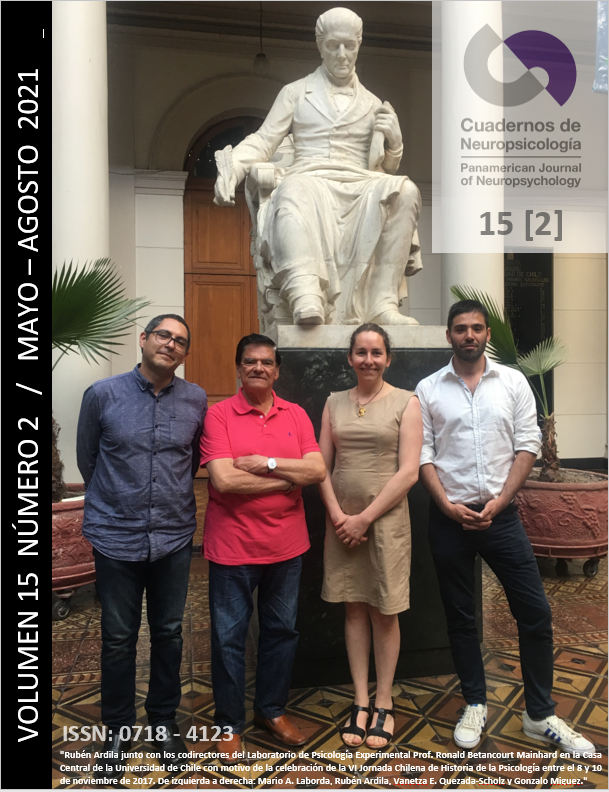Unidad y Diversidad de las Funciones Ejecutivas: El modelo de variables latentes de Miyake, Emerson y Friedman (2000) y Friedman y Miyake (2017)
Abstract
R E S U M E NDefinir y evaluar las funciones ejecutivas (FEs) sigue siendo un problema. Su apariencia unitaria en determinados contextos y su diversidad en otros genera dudas sobre su definición, su operacionalización, su medición y estudio, cuestionando la validez y confiabilidad de los resultados obtenidos a través de la evaluación neuropsicológica de las FEs. El Modelo de Variables Latentes de las FEs de Miyake et al. (2000) y Friedman y Miyake (2017) es una propuesta metodológica valiosa para resolver el problema presente. El modelo ha permitido explicar el patrón unitario y diverso de las FEs, desde su primera propuesta donde señalaba la Inhibición, Actualización y Cambio a nivel de variables latentes, hasta el modelo actual que resalta un Factor Común de la Funciones Ejecutivas y dos Factores EspecÃficos -Actualización y Cambio-. Además, ha sido útil para responder los problemas conceptuales y de medida de las FEs (Miyake, A, Emerson, M. J y Friedman, N.P., 2000). El objetivo del presente texto es presentar de manera breve la propuesta de variables latentes de las FEs de Miyake et al. (2000) y de Friedman y Miyake (2017) para resolver el problema de la definición y evaluación de las FEs.
Palabras Clave: Funciones Ejecutivas (FEs), Inhibición, Actualización, Cambio, Variables Latentes, Corteza Prefrontal. Â
A B S T R A C T
Defining and assessing executive functions (EFs) remains unresolved. Their unitary appearance in certain contexts and their diversity in others raises doubts about their definition, their operationalization, their measurement, and study, putting into question the validity and reliability of the results obtained through the neuropsychological assessment of EFs. The Latent Variables Model of EFs by Miyake et al. (2000) and Friedman and Miyake (2017) is a valuable methodological proposal to solve the present problem. The model has allowed explaining the unitary and diverse pattern of EFs. From its first proposal where it pointed out Inhibition, Updating and Shifting at the latent variable level, to the current model that remarks a Common Factor of the EFs and two Specific Factors -Updating and Shifting-. In addition, it has been useful both in answering conceptual and measurement problems of EFs (Miyake, A, Emerson, M. J and Friedman, N.P., 2000). The aim of the present text is to briefly present the proposal of latent variables of EFs by Miyake et al. (2000) and Friedman and Miyake (2017) to solve the definition and assessment problem of EFs.
Keywords: Executive Functions (EFs), Inhibition, Updating, Shifting, Latent variables, Prefrontal Cortex.
R E S U M O
Definir e avaliar as funções executivas (FEs) segue sendo um problema. Sua aparição unitária em determinados contextos e sua diversidade em outros gera dúvidas sobre sua definição, sua operacionalização, sua medição e estudo, questionando a validade e confiabilidade dos resultados obtidos através da avaliação neuropsicológica das FEs. O Modelo de Variáveis Latentes das FEs de Miyake et al. (2000) e Friedman e Miyake (2017) é uma proposta metodológica valiosa para resolver o problema presente. O modelo tem permitido explicar o padrão unitário e diverso das FEs, desde a sua primeira proposta onde sinalizava a Inibição, Atualização e Flexibilidade Cognitiva* a nÃvel de variáveis latentes, até o modelo atual que ressalta um Fator Comum das Funções Executivas e dos Fatores EspecÃficos – Atualização e  Flexibilidade . Além disso, tem sido útil para responder os problemas conceituais e de medida das FEs (Miyake, A, Emerson, M. J e Friedman, N.P., 2000). O objetivo do presente texto é apresentar de maneira breve a proposta de variáveis latentes das FEs de Miyake et al. (2000) e de Friedman e Miyake (2017) para resolver o problema da definição e avaliação das FEs.
Palavras-chave: Funções executivas (FEs), Inibição, Atualização,  Flexibilidade Cognitiva, Variáveis Latentes, Córtex Pré-frontal
Downloads
How to Cite
Issue
Section
License
Articles published in this journal are protected under the Creative Commons Attribution-NonCommercial-ShareAlike 4.0 International (CC BY-NC-SA 4.0) license. This means that authors retain full rights over their research and publications at all times. As a journal, we fully respect and promote the principles of open access established by this license, allowing the work to be shared, adapted, and distributed for non-commercial purposes, provided that appropriate credit is given to the authors and any derivative works are licensed under the same terms.
Authors are responsible for obtaining the required permission when they wish to reproduce part of the material (figures, etc.) from other publications.
Likewise, CNPs allows authors to host in their personal sites or other repositories that they deem convenient the Final and Definitive Version of the published article with the format assigned by the journal. In no case do we allow access to preprints of the article under evaluation or already published.
When submitting an article to CNPs you are aware that all the contents of CNPs are under a Creative Commons License. In which it is allowed to copy and share the contents freely, always making reference to the origin of the publication and its author.





